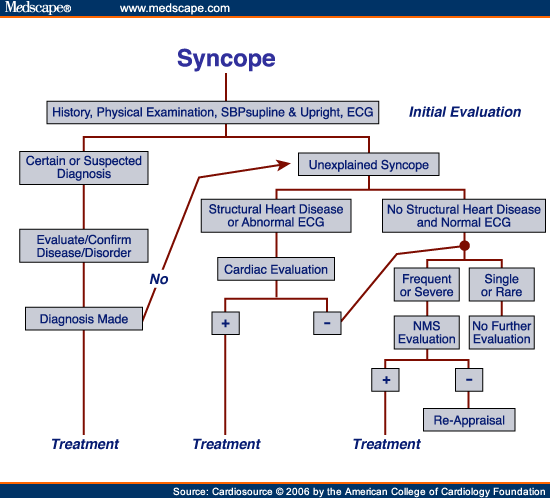What is syncope?
![[Woman fainting]](http://cdn1.medicalnewstoday.com/content/images/articles/182/182524/woman-fainting.jpg)
Fainting can sometimes be a sign of a more serious illness, or nothing to worry about at all.
Sometimes syncope may be just that – a fainting episode with no medical importance. On some occasions, however, it may be caused by a serious illness, condition or disorder. Every case of fainting should be treated as a medical emergency until the cause is known and signs and symptoms have been treated. Anybody who has recurring fainting episodes should contact their doctor.
If oxygen levels are below 16% at atmospheric pressure most people faint due to hypoxia. If oxygen levels fall below 11% individuals may die by suffocation. The amount of oxygen in the air depends on its partial pressure – inhaling pressurized gas while scuba diving which is below 16% oxygen does not cause hypoxia (because the air is pressurized).
Syncope due to hypoxia may also be caused by malfunctioning lungs, problems with blood circulation, or carbon monoxide poisoning. Some people faint at the sight of blood, or when receiving an injection or seeing somebody having one.
In Victorian England (19th Century) fainting in women was a commonplace stereotype, as well as modern portrayals of that period. Some believe that the respiratory effects of tight corsets worn at the time may have been a contributory factor. However, during Victorian times aristocratic women were encouraged to display a feminine frailty by fainting at dramatic moments.
Children sometimes play a game (fainting game) in which they deliberately restrict blood flow to the brain in order to trigger syncope – this is dangerous and may cause brain damage, and even death.
Near-syncope vs syncope
- Pre- or near-syncope (a pre- or near-syncoptic episode) – this is when the person can remember events during the loss of consciousness, such as dizziness, blurred vision, muscle weakness, as well as the fall before hitting their head and losing consciousness.
- Syncope (a syncoptic episode) – this is when the individual may remember the feelings of dizziness and loss of vision, but not the fall.

Symptoms of syncope
The hallmark sign is evident to anyone around – the patient passes out, faints, suddenly loses consciousness.
The following signs and symptoms may precede a fainting episode:
- A feeling of heaviness in the legs
- Blurred vision
- Confusion
- Feeling warm or hot
- Lightheadedness, dizziness, a floating feeling
- Nausea
- Sweating
- Vomiting
- Yawning.
When a person faints, the following signs may be evident:
- The individual may be falling over
- The patient may be slumping
- The person may be unusually pale
- There may be a drop in blood pressure
- There may be a weak pulse.

What to do if somebody feels faint
You feel faint:
- Don’t stay standing up. Find somewhere to either sit or lie down.
- If you manage to sit down place your head between your knees.
- When you do get up, do so slowly.
If you see somebody fainting:
- Place the patient on his/her back, facing up
- If the individual is breathing, raise their legs about 12 inches (30 centimeters) above heart level to restore blood flow to the brain
- Try to loosen all belts, ties, collars and restrictive clothing
- When the person comes round do not let them get up too quickly
- If they remain unconscious for more than about a minute, put the patient into the recovery position and get emergency medical help
- Check the patient’s airway for any obstruction and check for vomiting
- Check for breathing, coughing or movement (signs of circulation). If you cannot detect any, start CPR (cardiopulmonary resuscitation). Continue administering CPR until either help arrives or the patient starts breathing on his/her own
- If the individual was injured and is bleeding after the fall, apply direct pressure to control the bleeding.
Treating syncope
If the fainting is found to be caused by an underlying health condition, that will need to be treated, which should help prevent syncoptic episodes.
- Treating neurocardiogenic syncope – in the majority of cases no further treatment is needed. Avoid the triggers, such as long periods standing still, dehydration, and being in hot and stuffy places. This may help prevent future episodes.
- Injections and blood – if the sight or thought of injections or blood make a person feel faint, they should tell the doctor or nurse beforehand. The health care professional can then make sure the patient is in a safe position (lying down) before any procedure begins.
- Beta-blockers – this medication is primarily used for the treatment of high blood pressure (hypertension). However, it may help patients whose neurocardiogenic syncope interferes with their quality of life. The side effects of beta-blockers may include fatigue, cold extremities (hands and feet), slow heartbeat (pulse rate), nausea, and diarrhea. Although rare, the following side effects are also possible – erectile dysfunction(impotence, problems either getting or sustaining an erection), nightmares, and sleep disturbances.

Post a comment